Warsaw Ghetto Heroes
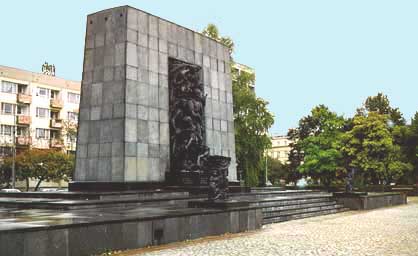 Nathan Rappaport Memorial
to Heroes of Warsaw Ghetto
Nathan Rappaport Memorial
to Heroes of Warsaw Ghetto
The date that the Nazis chose to destroy
the Warsaw Ghetto was on Passover, April 19, 1943. The leader
of the Jewish resistance movement, Mordechai Anielewicz, was
determined not to give up without a fight. By this time, the
Jews in the Ghetto knew that the daily trains to Treblinka
were not transporting the Jews to resettlement camps in the East,
but were taking them to a death camp to be killed in gas chambers.
It was because the ghetto reisdents began refusing to get on
the trains that the Nazis decided to liquidate the ghetto.
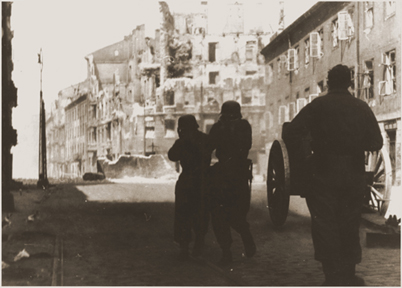 A gun crew of SS soldiers
battles the Jews in the Warsaw Ghetto
A gun crew of SS soldiers
battles the Jews in the Warsaw Ghetto
Ukrainian and Latvian auxillary SS soldiers
marched into the ghetto on April 19, 1943, entering at the northern
border of the Ghetto on Zamenhofa street. It was not until May
16 that the SS was able to defeat the handful of resistors, who
held out for 28 days, longer than the whole Polish army when
the Germans and the Russians jointly invaded Poland in September
1939.
On April 19, 1988, the 45th anniversary
of the Warsaw Ghetto uprising, a Memory Lane was marked out through
the former Ghetto. The route starts at the corner of ul. Anielewicza
and ul. Zamenhofa where a plaque tells you that this was the
site of the former Ghetto. The buildings were severely damaged
during the fighting, and the Ghetto was torn down. Jewish prisoners
were sent to Warsaw from the Auschwitz death camp to clear the
ruins of the Ghetto.
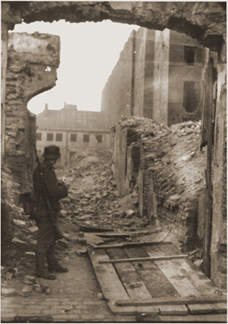 SS soldier stands in
the ruins of the Ghetto
SS soldier stands in
the ruins of the Ghetto
One of the stops on Memory Lane is the
monument pictured at the top of this page, which honors the Jewish
resistance fighters; it is the work of sculptor Nathan Rappaport
and is sometimes referred to as the Nathan Rappaport Memorial.
It is located on ul. Zamenhofa, the street where the fighting
began in the Warsaw uprising.
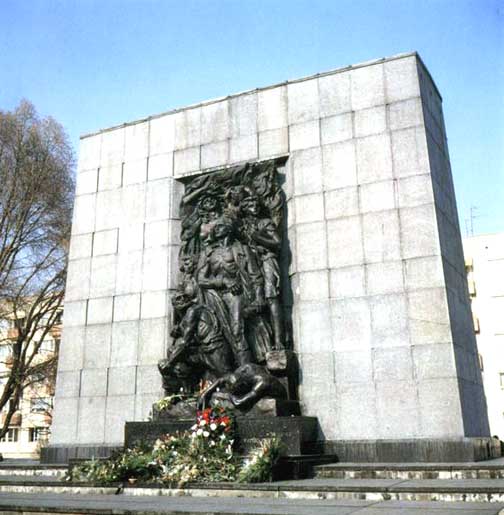 Front of the Warsaw
Ghetto Memorial
Front of the Warsaw
Ghetto Memorial
In the photo above, the front of the
monument is shown. It depicts several of the resistance fighters
with Anielewicz in the front holding a hand grenade in his hand.
At the start of the fight, a few hand grenades were virtually
the only weapons that the Jews had. After they killed a few SS
soldiers and the others retreated, the resistance fighters took
the weapons from the hands of the dead and continued the fight
the next day when the Nazis returned.
The photo below shows the back side of
the monument. It depicts a line of Jews marching to their death
in a concentration camp. In the courtyard where this monument
is located, and at many other places along the route of Memory
Lane, are black marble stones like gravestones in a symbolic
cemetery, honoring those who died in the ghetto and in the extermination
camps.
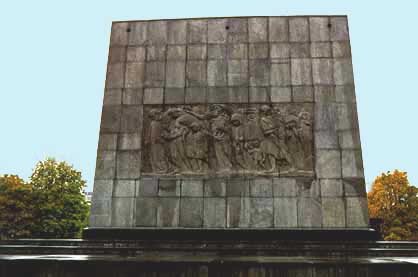 Back side of Memorial
to Heroes of Warsaw Ghetto
Back side of Memorial
to Heroes of Warsaw Ghetto
The photo below shows the statue called
"Little Insurgent" in Warsaw. It depicts a little boy
with a helmet that is too big for him, holding a machine gun.
When Warsaw was attacked by German troops in World War II, the
Polish children, both boys and girls aged 8 to 16, took it upon
themselves to become little soldiers and to help defend the city.
This photo was sent to us by one of our readers, who says that
"It is very important because it shows that even children
were willing to risk their lives to defend their country."
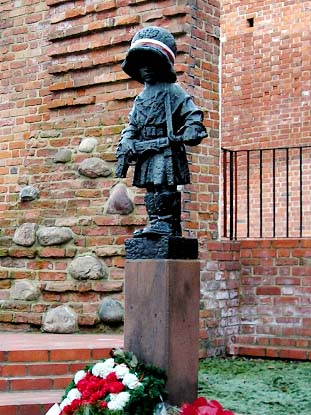 Statue of Little Insurgent
in Warsaw
Statue of Little Insurgent
in Warsaw
This page was last updated on September
25, 2008
|